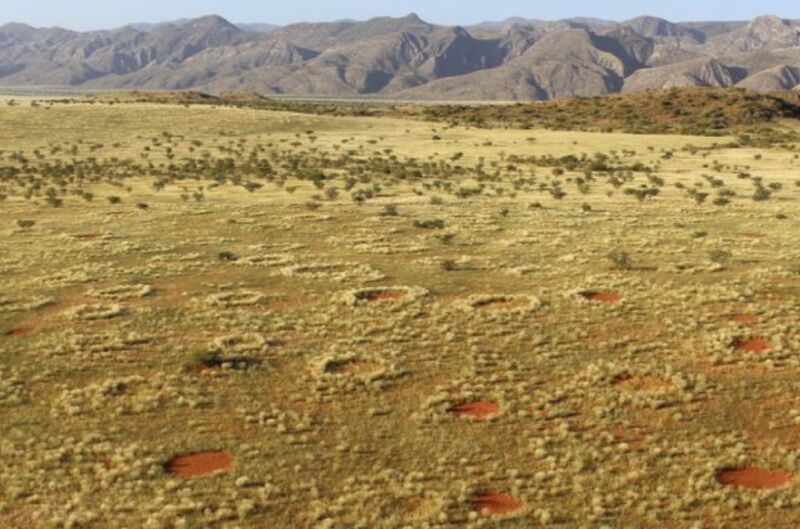Study offers four-point rebuttal to 2022 claim that they're a kind of eco-Turing pattern.

Bare, reddish-hued circular patches in the Namib Desert known as "fairy circles" are also found in northwestern Australia.
UHH/MIN/Juergens
Himba bushmen in the Namibian grasslands have long passed down legends about the region's mysterious fairy circles: bare, reddish-hued circular patches that are also found in northwestern Australia. In the last 10 years, scientists have heatedly debated whether these unusual patterns are due to sand termites or to an ecological version of a self-organizing Turing mechanism. Last year, a team of scientists reported what they deemed definitive evidence of the latter, thus ruling out sand termites, but their declaration of victory may have been premature. A recent paper published in the journal Perspectives in Plant Ecology, Evolution, and Systematics offers a careful rebuttal of those 2022 findings, concluding that sand termites may be to blame after all.
As we've reported previously, the fairy circles can be as large as several feet in diameter. Dubbed "footprints of the gods," it's often said they are the work of the Himba deity Mukuru, or an underground dragon whose poisonous breath kills anything growing inside those circles. Scientists have their own ideas.
One theory—espoused by study co-author Norbert Jürgens, a biologist at the University of Hamburg in Germany—attributed the phenomenon to a particular species of termite (Psammmotermes allocerus), whose burrowing damages plant roots, resulting in extra rainwater seeping into the sandy soil before the plants can suck it up—giving the termites a handy water trap as a resource. As a result, the plants die back in a circle from the site of an insect nest. The circles expand in diameter during droughts because the termites must venture farther out for food.
The other hypothesis—espoused by Stephan Getzin of the University of Göttingen—holds that the circles are a kind of self-organized spatial growth pattern, specifically a Turing pattern, that arise as plants compete for scarce water and soil nutrients. In his seminal 1952 paper, Alan Turing was attempting to understand how natural, non-random patterns emerge (like a zebra's stripes), and he focused on chemicals known as morphogens. He devised a mechanism involving the interaction between an activator chemical and an inhibitor chemical that diffuse throughout a system, much like gas atoms will do in an enclosed box. It's akin to injecting a drop of black ink into a beaker of water. Normally this would stabilize a system: the water would gradually turn a uniform gray. But if the inhibitor diffuses faster than the activator, the process is destabilized. That mechanism will produce a Turing pattern: spots, stripes, or, when applied to an ecological system, clusters of ant nests or fairy circles.
Getzin and colleagues published two papers in 2019 and a third in 2022 about their findings in support of the Turing pattern hypothesis, with Getzin telling Ars at the time, "We can definitively dismiss the termite hypothesis" about both Australian and Namibian fairy circles. He based that statement on the fact that his team could find no evidence of termite-damaged roots; rather, it was plant water stress that caused grasses to die inside the bare patch of fairy circles, based on their topsoil moisture measurements at a depth of 20 centimeters beneath the fairy circles. The grass plants self-organize unevenly and hence draw water unevenly to their roots and through diffusion in the sandy soils. The result is circular patches of dead grass.
Jürgens and co-author Alexander Gröngröft, also at the University of Hamburg, beg to differ, and their new paper offers a four-point rebuttal to Getzin et al. The rebuttals are based partly on new data samples collected between 2009 and 2022, as well as Getzin et al.'s measurements and observations from last year, which Jürgens claims were misinterpreted and are actually consistent with his 2013 soil analysis. In addition, Gröngröft analyzed the hydrological properties of desert sand in the laboratory to test Getzin et al.'s proposed diffusion mechanism for their self-organized Turing pattern hypothesis.
First, Jürgens and Gröngröft's findings showed that the grasses in the bare patch of the fairy circles don't die due to soil drought, as Getzin has suggested. Rather, their measurements, at four different depths up to 90 centimeters, showed that there was actually sufficient moisture because the subsoil can store water for a long period of time. The grasses die during the first few weeks when the soil beneath the bare patch is still moist. "Consequently, the early death of the grass plants within the bare patch must have another cause," they wrote.
Second, Jürgens and Gröngröft did not find evidence of a sufficiently strong "uptake-diffusion feedback" to cause liquid water to move horizontally or vaporize soil moisture over several meters within mere days, as Getzin et al. suggested. Granted, there was a lot of water conductivity in the sand during heavy rains, which seeped away rather quickly. But after that release, the soil conductivity dropped to very low levels, typical of the moisture levels measure below fairly circles. So there can only be very little liquid water transport over short distances, which doesn't fit the self-organizing hypothesis.
Third, they found that the grasses in the bare patch of the fairy circles first die in the center and later at the margin. And finally, they concluded that the grass in the bare patches dies due to damage to the roots caused by sand termites. Jürgens and Grongoft expressed astonishment at Getzin et al. finding no termites or termite nests in their 2022 study of fairy circles, given numerous prior studies that did find evidence of sand termites at fairy circle sites—including this latest study, which found sand termites on more than 1,700 fairy circles in Namibia, Angola, and South Africa.
Why the contradiction? Per the authors, it can be quite challenging to spot evidence of termite activity, both in the form of the fragile tunnels they dig, and in damage to grass roots (which often requires a magnifying lens to detect). Live termites are most easily observed in the early morning, so time of day matters during fieldwork. And the life spans of their colonies are much shorter than fairy circles; the latter can remain visible for several years, long after the colony has died off.
"The horizontal water transports over meters in a few days assumed by the representatives of self-regulation are physically impossible according to current knowledge," said Jürgens. "The debate about opposing interpretations of a biological phenomenon is thus surprisingly decided by physics, in this case soil physics. The soil moisture measurements on the fairy circles and the soil hydraulic properties of the sand found in the laboratory thus rule out the self-regulation hypothesis as an explanation for the fairy circles. The cause for the formation of the fairy circles is thus clear: it is the sand termites that secure a considerable survival advantage through soil moisture storage."
Source




3175x175(CURRENT).thumb.jpg.b05acc060982b36f5891ba728e6d953c.jpg)

Recommended Comments
There are no comments to display.
Join the conversation
You can post now and register later. If you have an account, sign in now to post with your account.
Note: Your post will require moderator approval before it will be visible.